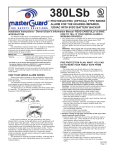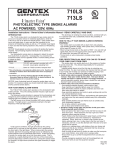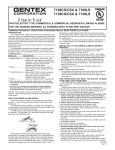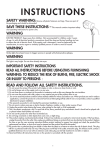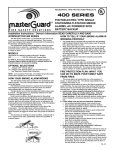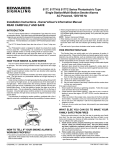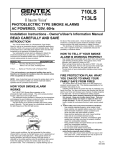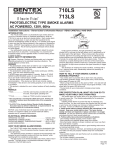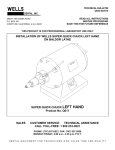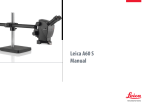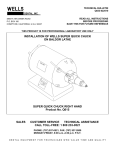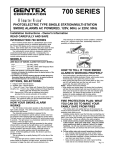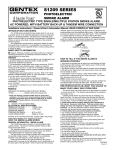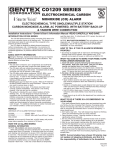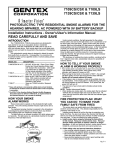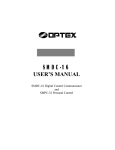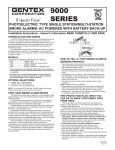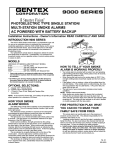Download 380 Series Manual
Transcript
RESIDENTIAL FIRE PROTECTION PRODUCTS 380 SERIES PHOTOELECTRIC RESIDENTIAL SMOKE ALARM, BATTERY POWERED Installation Instructions - Owner's Information READ CAREFULLY AND SAVE INTRODUCTION 380 SERIES The 380 Series smoke alarm is a photoelectric type alarm for use as a life saving device in residential applications. Each smoke alarm has a solid state piezo signal to warn and alert the household to the presence of threatening smoke. Your photoelectric smoke alarm is designed to detect the smoke that results from an actual fire. Consequently, it is uncommon for household smoke such as cigarette smoke or normal cooking smoke to cause an alarm. MODELS MODEL NO. 380................................. 380T............................... DESCRIPTION 9 Volt DC Battery Smoke Alarm, Wall or Ceiling Mount with Pulsating Piezo Horn plus a visual Power-On/Alarm Indicator LED Model 380 with Integral 135°F. Thermal Sensor HOW YOUR SMOKE ALARM WORKS The 380 Series smoke alarm operates on the photoelectric light scatter principle. The unit's sensing chamber houses a light source and a light sensor. The darkened sensing chamber is exposed to the atmosphere and designed to permit optimum smoke entry from any direction while rejecting light from outside the smoke alarm. The light source is an infrared (invisible) LED which pulses every 8 seconds. The light sensor is a photodiode matched to the light frequency of the LED light source. Under normal conditions, the light generated by the pulsing infrared LED is not seen by the light sensor, as it is positioned out of the direct path of the light beam. When smoke enters the sensing chamber, light from the pulsing LED light source is reflected by the smoke particles onto the photodiode light sensor. At the first sighting of smoke, the smoke alarm is put into a pre-alarm mode. This is indicated by a rapidly flashing LED on the face of the smoke alarm. Once the light sensor confirms smoke for 2 consecutive pulses inside the chamber, the light sensor produces the signal necessary to trigger the alarm. This technique of verifying the smoke condition substantially reduces the possibility of nuisance alarms. FIRE PROTECTION PLAN: WHAT YOU CAN DO TO MAKE YOUR FAMILY SAFE FROM FIRES This smoke alarm can quickly alert you to the presence of smoke-it cannot prevent fire. The ultimate responsibility for fire protection rests solely on you. Installing smoke alarms is just the first step in protecting your family from fires. You also must reduce the chances that fires will start in your home and increase your chances of safely escaping if one does start. To have an effective fire safety program: a. Install smoke alarms properly following the instructions in this manual. Keep your smoke alarms clean. Test your device weekly and have it repaired or replaced when it no longer functions. As with any electronic product, smoke alarms have a limited life, and devices that don't work cannot protect you. b. Follow safety rules and prevent hazardous situations: • Use smoking materials properly; never smoke in bed. • Keep matches and cigarette lighters away from children. • Store flammable materials in proper containers and never use them near open flames or sparks. • Keep electrical appliances and cords in good working order and do not overload electrical circuits. • Keep stoves, fireplaces, chimneys, and barbecue grills greasefree and make sure they are properly installed away from combustible materials. • Keep portable heaters and open flames such as candles away from combustible materials. • Do not allow rubbish to accumulate. • Do not leave small children home alone. c. Develop a family escape plan and practice it with your entire family, especially small children. • Draw and post a floor plan of your home and find two ways to exit from each room. There should be one way to get out of each bedroom without opening the door. • Teach children what the smoke alarm signal means, and that they must be prepared to leave the residence by themselves if necessary. Show them how to check to see if doors are hot before opening them, how to stay close to the floor and crawl if necessary, and how to use the alternate exit if the door is hot and should not be opened. • Decide on a meeting place a safe distance from your house and make sure that all your children understand that they should go and wait for you if there is a fire. • Hold fire drills at least every 6 months to make sure that everyone, even small children, know what to do to escape safely. • Know where to go to call the fire department from outside your residence. • Provide emergency equipment such as fire extinguishers and teach your family to use this equipment properly. d. Bedroom doors should be closed while sleeping if a smoke alarm is installed in the bedroom. They act as a barrier against heat and smoke. Pg. 3-1 WHAT TO DO IF THERE IS A FIRE IN YOUR HOME If you have prepared family escape plans and practiced them with your family, you have increased their chances of escaping safely. Review the following rules with your children when you have fire drills so everyone will remember them in a real fire emergency. If the smoke alarm should sound: a. Don't panic; stay calm. Your safe escape may depend on thinking clearly and remembering what you have practiced. b. Get out of the house following a planned escape route as quickly as possible. Do not stop to collect anything or to get dressed. c. Open doors carefully only after feeling to see if they are hot. Do not open a door if it is hot; use an alternate escape route. d. Stay close to the floor; smoke and hot gases rise. e. Cover your nose and mouth with a cloth, wet if possible, and take short, shallow breaths. f. Keep doors and windows closed unless you open them to escape. g. Meet at your prearranged meeting place after leaving the house. h. Call the Fire Department as soon as possible from outside your house. Give the address and your name. i. Never re-enter a burning building. Contact your local Fire Department for more information on making your home safer from fires and about preparing your family's escape plans. NOTE: Current studies have shown smoke alarms may not awaken all sleeping individuals, and that it is the responsibility of individuals in the household that are capable of assisting others to provide assistance to those who may not be awakened by the alarm sound, or to those who may be incapable of safely evacuating the area unassisted. WHAT THIS SMOKE ALARM CAN DO This smoke alarm is designed to sense smoke entering its sensing chamber. It does not sense gas, heat (except for the 380T), or flames. When properly located, installed, and maintained, this smoke alarm is designed to provide early warning of developing fires at a reasonable cost. This smoke alarm monitors the air and, when it senses smoke, activates its built-in alarm horn. It can provide precious time for you and your family to escape from your residence before a fire spreads. Such an early warning, however, is possible only if the smoke alarm is located, installed, and maintained as specified in this User's Manual. NOTE: This smoke alarm is designed for use within a single residential living unit only; that is, it should be used inside a single-family home or one apartment of a multi-family building. In a multi-family building, the device may not provide early warning for residents if it is placed outside of the residential units, such as on outside porches, in corridors, lobbies, basements, or in other apartments. In multi-family buildings, each residential unit should have smoke alarms to alert the residents of that unit. Smoke alarms designed to be interconnected should be interconnected within one family residence only; otherwise, nuisance alarms will occur when a smoke alarm in another living unit is tested. IMPORTANT NOTE: WHAT SMOKE ALARMS CANNOT DO Smoke alarms will not work without power. Batteryoperated smoke alarms will not work without batteries, with dead batteries, or if the batteries are not installed properly. If you are concerned about the reliability of either the batteries or your AC power supply for any of the above reasons, you should install both battery and AC powered smoke alarms for maximum safety. Smoke alarms may not sense fires that start where smoke cannot reach the devices such as in chimneys, in walls, on roofs, or on the other side of closed doors. If bedroom doors are usually closed at night, smoke alarms should be placed in each bedroom as well as in the common hallway between them. Smoke alarms also may not sense a fire on another level of a residence or building. For example, a second-floor smoke alarm may not sense a first-floor or basement fire. Therefore, smoke alarms should be placed on every level of a residence or building. The horn in your smoke alarm meets or exceeds current audibility requirements of Underwriters Laboratories. However, if the smoke alarm is located outside a bedroom, it may not wake up a sound sleeper, especially if the bedroom door is closed or only partly open. If the smoke alarm is located on a different level of the residence than the bedrooms, it is even less likely to wake up people sleeping in the bedroom. In such cases, the National Fire Protection Association recommends that the smoke alarms be interconnected so that a device on any level of the residence will sound an alarm loud enough to awaken sleepers in closed bedrooms. This can be done by installing a fire-detection system or by using radio frequency transmitters and receivers. All types of smoke alarm sensors have limitations. No type of smoke alarm can sense every kind of fire every time. In general, smoke alarms may not always warn you about fires caused by violent explosions, escaping gas, improper storage of flammable materials, or arson. NOTE: This smoke alarm is not designed to replace specialpurpose fire detection and smoke alarm systems necessary to protect persons and property in non-residential buildings such as warehouses, or other large industrial or commercial buildings. It alone is not a suitable substitute for complete fire-detection systems designed to protect individuals in hotels and motels, dormitories, hospitals, or other health and supervisory care and retirement homes. Please refer to NFPA 101,The Life Safety Code, and NFPA 72 for smoke alarm requirements for fire protection in buildings not defined as "households." Installing smoke alarms may make you eligible for lower insurance rates, but smoke alarms are not a substitute for insurance. Home owners and renters should continue to insure their lives and property. PLACEMENT OF SMOKE ALARMS THIS EQUIPMENT SHOULD BE INSTALLED IN ACCORDANCE WITH THE NATIONAL FIRE PROTECTION ASSOCIATION'S STANDARD 72 (National Fire Protection Association, Batterymarch Park, Quincy, MA 02269). For your information, the National Fire Protection Association's Standard 72, reads as follows: NFPA 72, 2007 Edition, Chapter 11, Section 11.5.1.1 Where required by applicable laws, codes or standards for a specific type of occupancy, approved single and multiple-station smoke alarms shall be installed as follows: 1) In all sleeping rooms and guest rooms 2) Outside of each separate dwelling unit sleeping area, within 6.4m (21ft) of any door to a sleeping room, the distance measured along a path of travel 3) On every level of a dwelling unit, including basements 4) On every level of a residential board and care occupancy (small facility), including basements and excluding crawl spaces and unfinished attics 5) In the living area(s) of a guest suite 6) In the living area(s) of a residential board and care occupancy (small facility) The installation of additional alarms of either the smoke or heat type should result in a higher degree of protection. Adding alarms to rooms that are normally closed off from the required alarms increases the escape time because the fire does not need to build to the higher level necessary to force smoke out of the closed room to the required alarms. As a consequence, it is recommended that the householder consider the installation of additional fire protection devices. However, it should be understood that NFPA 72 does not require additional smoke alarms over and above those called for in Figures 1, 2, 3 and 4 where required smoke alarms are shown. Figure 1 Figure 1: A SMOKE ALARM SHOULD BE LOCATED ON EVERY LEVEL OF DWELLING UNIT, INCLUDING BASEMENT, WITHIN EACH SLEEPING ROOM AND OUTSIDE SLEEPING AREAS. Pg. 3-2 Where to Locate the Required Smoke Alarms. The major threat from fire in a dwelling unit occurs at night when everyone is asleep. Persons in sleeping areas can be threatened by fires in the remainder of the unit; therefore, smoke alarms are best located in each bedroom and between the bedroom areas and the rest of the unit as shown in Figure 2. Figure 2 Are More Smoke Alarms Desirable? The required number of smoke alarms might not provide reliable early warning protection for those areas separated by a door from the areas protected by the required smoke alarms. For this reason, the use of additional smoke alarms for those areas for increased protection is recommended. The additional areas include the basement, bedrooms, dining room, furnace room, utility room, and hallways not protected by the required smoke alarms. The installation of smoke alarms in kitchens, attics (finished or unfinished), or garages is not normally recommended, because these locations occasionally experience conditions that can result in improper operation. IMPORTANT CONSIDERATION The National Fire Protection Association (NFPA) recommends replacing your smoke alarm(s) every ten (10) years; why: • Dust, dirt, and other environmental contaminants can affect your smoke alarm over a prolonged period. Figure 2: A SMOKE ALARM SHOULD BE LOCATED BETWEEN THE SLEEPING AREA AND THE REST OF THE DWELLING UNIT AS WELL AS IN EACH BEDROOM. In dwelling units with more than one bedroom area or with bedrooms on more than one floor, more than one smoke alarm is required, as shown in Figure 3. Figure 3 • Fast changing industry consensus standards and codes on all devices make it advisable to periodically upgrade your smoke alarm to maximize life safety. • Assurance that your smoke alarm needs are kept abreast with the constantly improving electronic technology. • Smoke alarms are recognized as one of the lowest cost ways to protect dwelling inhabitants against the danger of fire(s). It makes good common sense to periodically replace and update your smoke alarm that contributes so much to life safety. MOUNTING LOCATION This smoke alarm can be mounted on a ceiling or wall with equal efficiency in either location. • Ceiling location-smoke alarm should be mounted as close as possible to the center of a hallway or room. If this is not possible, the edge of the smoke alarm should be at least 4 inches from any wall. Figure 3: IN DWELLING UNITS WITH MORE THAN ONE SLEEPING AREA, A SMOKE ALARM SHOULD BE PROVIDED TO PROTECT EACH SLEEPING AREA IN ADDITION TO SMOKE ALARMS REQUIRED IN BEDROOMS. In addition to smoke alarms outside of the sleeping areas and in each bedroom, NFPA 72 requires the installation of a smoke alarm on each additional level of the dwelling unit, including the basement. These installations are shown in Figure 4. The living area smoke alarm should be installed in the living room or near the stairway to the upper lever, or in both locations. The basement smoke alarm should be installed in close proximity to the stairway leading to the floor above. Where installed on an open-joisted ceiling, the smoke alarm should be placed on the bottom of the joists. The smoke alarm should be positioned relative to the stairway so as to intercept smoke coming from a fire in the basement before the smoke enters the stairway. • Wall location-locate the top of the smoke alarm at least 4 inches and not more than 12 inches from the ceiling. Observe smoke alarm for proper top/bottom orientation (test knob is near bottom of unit). Figure 5 Figure 4 Figure 5: RECOMMENDED SMOKE ALARM MOUNTING LOCATIONS. Figure 6 Figure 6: RECOMMENDED SMOKE ALARM LOCATION IN ROOMS WITH SLOPED, GABLED, OR PEAKED CEILINGS. Figure 4: A SMOKE ALARM SHOULD BE LOCATED ON EACH LEVEL IN ADDITION TO EACH BEDROOM. The placement of the smoke alarm is critical if maximum speed of fire detection is desired. Thus, a logical location for a smoke alarm is the center of the ceiling. At this location, the smoke alarm is closest to all areas of the room. Figures 1, 2, 3, & 4 are reprinted with permission from NFPA 72, National Fire Alarm Code®, Copyright ©2002, National Fire Protection Association, Quincy, MA 02169. This reprinted material is not the complete and official position of the National Fire Protection Association on the referenced subject which is represented only by the standard in its entirety. National Fire Alarm Code® and NFPA 72® are registered trademarks of the National Fire Protection Association, Inc., Quincy, MA 02169. Pg. 3-3 WHERE SMOKE ALARMS SHOULD BE PUT IN MOBILE HOMES In mobile homes built after about 1978 that were designed and insulated to be energy-efficient, smoke alarms should be installed as described in the section above. In older mobile homes that have little or no insulation compared to today's standards, uninsulated metal outside walls and roofs can transfer heat and cold from outdoors, making the air right next to them hotter or colder than the rest of the inside air. These layers of hotter or colder air can prevent smoke from reaching a smoke alarm. Therefore, put smoke alarms in such units only on inside walls, between 4 and 12 inches (10 and 30 cm) from the ceiling. If you are not sure about the insulation level in your mobile home, or if you notice that the walls or ceiling are unusually hot or cold, put the smoke alarm on an inside wall. Minimum protection requires one smoke alarm as close to the sleeping area as possible. For better protection, put one smoke alarm in each room, but first read the "Locations to Avoid." LOCATIONS TO AVOID Nuisance alarms are caused by placing smoke alarms where they will not operate properly. To avoid nuisance alarms, do not place smoke alarms: • In or near areas where combustion particles are normally present such as kitchens; in garages where there are particles of combustion in vehicle exhausts; near furnaces, hot water heaters, or gas space heaters. Install smoke alarms at least 20 feet (6 meters) away from kitchens and other areas where combustion particles are normally present. • In air streams passing by kitchens. Figure 7 shows how a smoke alarm can be exposed to combustion particles in normal air movement paths, and how to correct this situation. Figure 7 WARNING: Never remove battery from the smoke alarm to silence a nuisance alarm. Open a window or fan the air around the smoke alarm to remove the smoke. The smoke alarm will automatically turn off when the smoke in the air is completely gone. Do not stand close to the smoke alarm. The sound produced by the smoke alarm is loud because it is designed to awaken you in an emergency. Prolonged exposure to the horn at a close distance may be harmful to your hearing. INSTALLATION 380 SERIES CAUTION: New Construction: DO NOT attach smoke alarm head until AFTER sanding, insulation, painting, and other dust creating situations are finished and cleaned up. MOUNTING: PLATE & SMOKE ALARM 1. Remove the mounting plate from the back of the smoke alarm by rotating it counter-clockwise until plate unsnaps. 2. Mount plate to either the wall or ceiling, see "Mounting Location" instructions. If smoke alarm is to be placed on the wall, mount plate so the snap-in tabs are in a vertical position. NOTE: PLATE IS MARKED "THIS SIDE OUT" FOR PROPER MOUNTING. 3. To use the supplied screw anchors, drill two 3/16" holes, insert the screw anchors, and mount the plate to wall using the supplied screws. 4. Place the smoke alarm up to the mounting plate, rotating it to about 10:00 o'clock then rotate it clockwise to 12:00. It should "snap-lock" firmly into place. Keep the smoke alarm parallel to the mounting plate so upper and lower tabs on the plate seat into the smoke alarm. • In damp or very humid areas, or next to bathrooms with showers. The moisture in humid air can enter the sensing chamber as water vapor, then cool and condense into droplets that cause a nuisance alarm. Install smoke alarms at least 10 feet (3 meters) away from bathrooms. • In very cold or very hot environments, or in unheated buildings or outdoor rooms, where the temperature can go below or above the operating range of the device. Temperature limits for proper operation are 40° to 100°F (4.4° to 37.8°C). • In very dusty or dirty areas. Dust and dirt can build up on the smoke alarm's sensing chamber and can make it overly sensitive, or block openings to the sensing chamber and keep the smoke alarm from sensing smoke. • Near fresh air inlets or returns or excessively drafty areas. Air conditioners, heaters, fans, and fresh air intakes and returns can divert smoke away from smoke alarms, making the devices less effective. BATTERY INSTALLATION 1. Once smoke alarm is mounted, the cover can be opened by using the pull tab located on right side of cover. 2. Use a fresh 9 volt Duracell MN 1604 battery, connect it to terminals located near upper right-hand corner inside the smoke alarm after first resetting battery removal flag back to its stand-by condition. 3. Re-close smoke alarm by snapping cover shut. 4. After battery has been installed or replaced, test smoke alarm. To test smoke alarm, follow procedures under CHECKOUT & TROUBLESHOOTING Section of this manual. • In dead air spaces at the top of a peaked roof or in the corners between ceilings and walls. Dead air may prevent smoke from reaching a smoke alarm. See Figures 5 and 6 for recommended mounting locations. • In insect-infested areas. If insects enter a smoke alarm's sensing chamber, they may cause a nuisance alarm. Get rid of the bugs before installing smoke alarms where bugs are a problem. • Near fluorescent light fixtures. Electrical "noise" from nearby fluorescent light fixtures may cause a nuisance alarm. Install smoke alarms and fluorescent lights on separate electrical circuits. Pg. 3-4 CHECKOUT & TROUBLESHOOTING 1. Testing with the Test Knob: a. Rotate the test knob counter-clockwise to the TEST 1 position and wait up to 20 seconds for the alarm to sound. If the smoke alarm does not sound after 20 seconds, check the battery connection. If the battery is good but the alarm does not sound, return the smoke alarm to the manufacturer for service. See "To Return a Smoke Alarm." b. After successfully testing the smoke alarm, return the test knob to NORMAL (non-test) position and wait 20 seconds for the smoke alarm to stop sounding. c. To test smoke alarm for high sensitivity, turn test knob clockwise to TEST 2 position. Smoke alarm should remain silent. Make sure to return test knob back to its normal position. If your smoke alarm sounds during this test it means the smoke alarm's sensitivity has become too high and may cause false alarms. This could mean your smoke alarm is dirty and should be cleaned as described in the maintenance procedure below. If the smoke alarm continues to alarm for TEST 2 position following cleaning return it to MasterGuard for service. d. To check for proper smoke entry into your smoke alarm's sensing chamber. MasterGuard recommends using the Home Safeguard Smoke Spray or CHEKKIT® SMOKE Detector Tester from SDI . This test should be performed once a year and should be sprayed from a distance no closer than 12 inches from smoke alarm. IMPORTANT: The test knob is not an electrical switch, nor is it connected in any way to the smoke alarm. Therefore, when you test with the test knob, you are actually simulating a smoke condition in the smoke alarm, as well as testing the sensitivity of the photodiode and the circuit between the photodiode and the alarm. 4. Add 1/8 cup of Ivory dishwashing liquid to the first bucket of water and allow it to mix thoroughly, then place one dirty smoke alarm into the soap water mixture until it becomes completely covered or submerged. NOTE: If the smoke alarms are exceptionally dirty, you may wish to first wipe off any excess dirt before washing smoke alarm so as not to dirty the wash water too quickly. DO NOT open smoke alarm for cleaning. IF SMOKE ALARM IS OPENED DURING CLEANING, PRODUCT WARRANTY BECOMES VOID. WARNING: ONLY IVORY DISHWASHING LIQUID IS TO BE USED. OTHER BRANDS ARE NOT RECOMMENDED AND MAY CAUSE YOUR SMOKE ALARM TO MALFUNCTION. 5. Allow smoke alarm to soak for approximately 10 minutes (longer if extremely dirty). Then agitate for 5 or 10 seconds to flush out any remaining dirt left inside smoke alarm's housing. 6. Remove smoke alarm from wash water and transfer directly to one of the first rinse buckets containing clear water. Again, allowing smoke alarm to become completely submerged, agitate once more for 5 or 10 seconds to remove soap residue. 7. Finally, transfer smoke alarm to your second and final rinse bucket, repeating method found in Step 6, then remove smoke alarm to a clean dry area for a period of 48 hours to allow it to thoroughly dry. 8. Install battery into the smoke alarm, mount the unit and repeat test procedure to verify proper operation. WARNING: SMOKE ALARMS ARE TO BE AIR DRIED ONLY. DO NOT PLACE SMOKE ALARM IN OVEN, MICROWAVE OR USE A HOT AIR BLOWER TO ACCELERATE DRYING TIME. THIS COULD RESULT IN DAMAGE TO YOUR SMOKE ALARM. IMPORTANT: IT IS RECOMMENDED TO CHANGE WASH AND RINSE WATER AFTER FIVE (5) SMOKE ALARMS. IF YOUR UNITS ARE EXTREMELY DIRTY, WATER SHOULD BE CHANGED MORE FREQUENTLY. WARNING: If the smoke alarm does not work properly, do not try and fix it yourself. This will void your warranty. See "To Return a Smoke Alarm" for instructions to return smoke alarms that do not operate properly. DO NOT TRY TO FIX IT YOURSELF. e. Turn test knob to the NORMAL position. The red indicator light should flash every 30 seconds, showing that the smoke alarm has power. f. If the red light is not flashing, check the battery connection. If the battery is good but the red light does not flash, return the smoke alarm for service. MAINTENANCE Your 380 Series smoke alarm is equipped with a weak battery indication, which will sound a BEEP every 30 seconds, when the battery needs replacing. This trouble signal will last for a minimum of 7 days. After your smoke alarm has been in operation for a period of time or if it was installed prior to the completion of all building construction, your smoke alarm may have become more sensitive due to dirt build-up in the smoke alarm's optic sensing chamber which could cause nuisance alarms or could cause activation from small amounts of smoke build-up. If this should occur, following this simple washing procedure will restore your smoke alarm back to its original condition. For further information, regarding frequency of cleaning and testing, refer to NFPA 72, NFPA, Batterymarch Park, Quincy, MA 02269. IMPORTANT: Failure to follow full cleaning instructions could result in damage to this smoke alarm. DO NOT remove all smoke alarms at the same time for cleaning. 1. Remove battery from the smoke alarm. 2. Twist the smoke alarm counter-clockwise to remove it from its mounting plate. 3. Select three (3) standard size wash buckets and fill them each with one gallon of normal tap water (distilled or de-ionized treated water is recommended as a final rinse if water is extremely hard in your area). WARNING: Smoke alarms are not to be used with detector guards unless the combination has been evaluated and found suitable for that purpose. FAILURE TO REGULARLY CLEAN THIS SMOKE ALARM WILL RESULT IN FALSE ALARMS. A BUILD UP OF DUST CREATES AN OBSCURATION THAT SIMULATES SMOKE. THIS MEANS THE UNIT WILL GO INTO ALARM WITHOUT A FIRE CONDITION. TO RETURN A SMOKE ALARM Should you experience problems with your smoke alarm, proceed as follows: 1. Twist the smoke alarm counter-clockwise to remove it from its mounting plate. 2. Remove the battery from the smoke alarm and snap the cover back to the closed position. 3. Carefully pack (the manufacturer cannot be responsible for consequential damage) and return to the manufacturer. Include complete details as to exact nature of difficulties being experienced and date of installation. Return to: MasterGuard Corporation, 801 Hammond Street, Suite 200, Coppell TX 75019 ELECTRICAL SPECIFICATIONS MODELS 380 SERIES OPERATING VOLTAGE 9 VDC STANDBY CURRENT (AVG.) . . . .015 mA ALARM CURRENT (MAX.) . . . . . 9 mA THERMAL RATING (T OPTION) . . 135°F OPERATION TEMPERATURE . . . . . . . . . . . . . 40°F-100°F (4.4°C-37.8°C) HUMIDITY . . . . . . . . . . . . . . . . . 10%-93% BATTERY OPERATED MODELS SHOULD USE DURACELL MN 1604. CAUTION: CONSTANT EXPOSURE TO HIGH OR LOW TEMPERATURE OR HIGH HUMIDITY MAY REDUCE BATTERY LIFE. Pg. 3-5 LIMITED WARRANTY For a period of 24 months from the date of purchase, MasterGuard warrants to you, the original consumer purchaser, that your Smoke Alarm will be free from defects in workmanship, materials, and construction under normal use and service. If a defect in workmanship, materials, or construction should cause your Smoke Alarm to become inoperable within the warranty period, MasterGuard will repair your Smoke Alarm or furnish you with a new or rebuilt replacement Smoke Alarm without charge to you except for postage required to return the Smoke Alarm to us. Your repaired or replacement Smoke Alarm will be returned to you free of charge and it will be covered under this warranty for the balance of the warranty period. This warranty is void if our inspection of your Smoke Alarm shows that the damage or failure was caused by abuse, misuse, abnormal usage, faulty installation, improper maintenance, or repairs other than those performed by us. ANY WARRANTIES IMPLIED UNDER ANY STATE LAW, INCLUDING IMPLIED WARRANTIES OF MERCHANTABILITY OR FITNESS FOR A PARTICULAR PURPOSE, APPLY ONLY FOR THE WARRANTY PERIOD SPECIFIED ABOVE. PLEASE NOTE THAT SOME STATES DO NOT ALLOW LIMITATIONS ON HOW LONG AN IMPLIED WARRANTY LASTS, SO THE ABOVE EXCLUSION MAY NOT APPLY TO YOU. MASTERGUARD WILL NOT BE LIABLE FOR ANY LOSS, DAMAGE, INCIDENTAL OR CONSEQUENTIAL DAMAGES OF ANY KIND ARISING IN CONNECTION WITH THE SALE, USE, OR REPAIR OF THIS SMOKE ALARM. PLEASE NOTE THAT SOME STATES DO NOT ALLOW THE EXCLUSION OR LIMITATION OF INCIDENTAL OR CONSEQUENTIAL DAMAGES. SO THE ABOVE EXCLUSION MAY NOT APPLY TO YOU. If a defect in workmanship, materials, or construction should cause your Smoke Alarm to become inoperable within the warranty period, you must return the Smoke Alarm to MasterGuard postage prepaid. You must also pack the Smoke Alarm to minimize the risk of it being damaged in transit. You must also enclose a return address. Smoke Alarms returned for warranty service should be sent to: MasterGuard Corporation, 801 Hammond Street, Suite 200, Coppell TX 75019. If we receive a Smoke Alarm in a damaged condition as the result of shipping, we will notify you and you must file a claim with the Shipper. THIS LIMITED WARRANTY GIVES YOU SPECIFIC LEGAL RIGHTS. YOU MAY ALSO HAVE OTHER RIGHTS WHICH VARY FROM STATE TO STATE. THIS IS YOUR COPY OF OUR LIMITED WARRANTY. PLEASE RETAIN IT WITH PROOF OF DATE OF PURCHASE IN A SAFE PLACE. 25 YEAR PRODUCT REPLACEMENT WARRANTY After the above Limited Warranty set forth in the Installation Instructions - Owner’s Information has expired, commencing in the 25th month and extending to the 324th month, MasterGuard guarantees to repair or replace your smoke alarm at a preferred customer discounted price which includes shipping and handling and is adjusted annually. The Product Replacement Warranty does not create any other obligations or liabilities of MasterGuard Corporation. This offer is extended only to the original purchaser and is available when the detector is sent to MasterGuard with a description of the problem and proof of purchase. This replacement offer is void if our inspection reveals that the damage or failure is a result of abuse, misuse, improper maintenance, abnormal usage, or unauthorized repairs. At least an annual washing (according to the directions supplied in this owner’s manual or www.masterguard.com) is recommended to prolong the useful life of your MasterGuard smoke detector. Contact MasterGuard for current pricing, then forward your check and smoke alarm with postage prepaid to MasterGuard. Enclose your return address and daytime telephone number. MasterGuard will ship the new replacement unit upon receipt of the above requirements. It should be noted that the National Fire Protection Association (N.F.P.A.), which is the national independent regulatory body for the fire protection industry, currently recommends that electronic smoke detectors be replaced after 10 years of use. Therefore, any MasterGuard smoke alarm over 10 years old is replaceable at this special discounted price without inspection. THIS PRODUCT REPLACEMENT POLICY SHALL HAVE NO EFFECT ON ANY WARRANTIES CONTAINED IN THE LIMITED WARRANTY. MASTERGUARD DISCLAIMS ANY OTHER DUTIES, EXPRESSED OR IMPLIED, INCLUDING ANY IMPLIED WARRANTIES OF MERCHANTABILITY OR FITNESS FOR A PARTICULAR PURPOSE. REPLACEMENT AT THE DISCOUNTED PRICE IS THE SOLE REMEDY UNDER THIS POLICY AND MASTERGUARD WILL NOT BE LIABLE FOR ANY LOSS, DAMAGE, INCIDENTAL OR CONSEQUENTIAL DAMAGES OF ANY KIND ARISING IN CONNECTION WITH THE SALE, USE, OR REPLACEMENT OF THE SMOKE ALARM OR WITH RESPECT TO THIS PRODUCT REPLACEMENT POLICY. PLEASE NOTE THAT SOME STATES DO NOT ALLOW THE EXCLUSION OR LIMITATION OF INCIDENTAL OR CONSEQUENTIAL DAMAGES, SO THE ABOVE EXCLUSION MAY NOT APPLY TO YOU. THIS PRODUCT REPLACEMENT POLICY GIVES YOU SPECIFIC LEGAL RIGHTS. YOU MAY ALSO HAVE OTHER RIGHTS, WHICH VARY FROM STATE TO STATE. Lifetime Fire Replacement Warranty MasterGuard will replace at no cost to the original owner any MasterGuard smoke detector that has been damaged or destroyed by an accidental fire. Any unit(s) or part(s) thereof that are damaged or destroyed must be returned to MasterGuard within 90 days of the fire (unless otherwise dictated by state or local laws) accompanied by a complete activation report and verification report from the local fire department to qualify for this free replacement Important Notice: These materials have been prepared by the Company for informational purposes only, are necessarily summary, and are not purported to serve as legal advice and should not be used as such. The Company makes no representations and warranties, express or implied, that these materials are complete and accurate, up-to-date, or in compliance with all relevant local, state and federal laws, regulations and rules. The materials do not address all legal considerations as there is inevitable uncertainty regarding interpretation of laws, regulations and rules and the application of such laws, regulations and rules to particular fact patterns. Each person's activities can differently affect the obligations that exist under applicable laws, regulations or rules. Therefore, these materials should be used only for informational purposes and should not be used as a substitute for seeking professional legal advice. The Company will not be responsible for any action or failure to act in reliance upon the information contained in this material. 550-0054-AA MASTERGUARD CORPORATION 801 Hammond Street, Suite 200, Coppell TX 75019 6-1-87 Pg. 3-6






